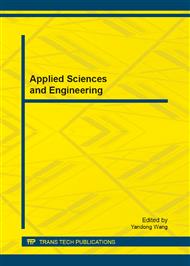[1]
T. S. Rappport, Wireless communications, principles and practice, 2nd ed. Prentice Hall, (2000).
Google Scholar
[2]
Mullen J, Haung H., Impact of multipath fading in wireless ad hoc networks. In: Proceedings of the second ACM workshop on performance evaluation of wireless ad hoc, sensor, and ubiquitous networks (PE-WASUN. 05); (2005).
DOI: 10.1145/1089803.1089984
Google Scholar
[3]
Toh, C. K. and Royer, E. M., A review of current routing protocols for ad hoc mobile wireless network, IEEE Personal Communications 15, 5 Apr, 1999, pp.46-55.
DOI: 10.1109/98.760423
Google Scholar
[4]
C. Siva Rama Murthy and B. S. Manoj, Ad hoc Wireless Networks: Architecture and protocols, Second edition, Prentice Hall, (2004).
Google Scholar
[5]
Clausen, T., Dearlove, C., Jacquet, P., The optimized link state routing protocol version 2, draft-ietf-manet-olsrv2-06, (2008).
DOI: 10.17487/rfc7188
Google Scholar
[6]
Tsuchiya, P. F., The Landmark Hierarchy: a new hierarchy for routing in very large networks, In Computer Communication Review, vol. 18, no. 4, Aug. 1988, pp.35-42.
DOI: 10.1145/52325.52329
Google Scholar
[7]
Perkins, C. E., Royer, E. M. and Das, S. R., Ad hoc on-demand distance vector (AODV) routing, Internet Draft, IETF, RFC 3561 , (2003).
DOI: 10.17487/rfc3561
Google Scholar
[8]
Motorola, C. I., Perkins, C., Dynamic MANET On- Demand (DYMO) Routing, draft-ietf-manet-dymo-12, (2008).
Google Scholar
[9]
Akyildiz, . F .I., Su, W., Sankarasubramaniam, Y . and Cayirci,E. 2002, A survey on sensor networks, " IEEE Communications magazine, vol. 40, No. 8 (Nov. 2002), pp.102-114. DOI=10. 1145/501417. 501420.
DOI: 10.1109/mcom.2002.1024422
Google Scholar
[10]
Varshney, M., Bagrodia, R., Detailed models for sensor network simulations and their impact on network performance, MSWim'04, ACM, (2004).
DOI: 10.1145/1023663.1023678
Google Scholar
[11]
Heinzeelman, W. B., Chandra Kasan, A., Bala Krishnan, H., Energy-Efficient communication protocol for wireless microsensor networks, In the Proceeding. of the 33rd Annual Hawaii Int'l Conf. on System Sciences. Maui: IEEE Computer Society, 2000, 3005-3014.
DOI: 10.1109/hicss.2000.926982
Google Scholar
[12]
Santivanez, A. C., McDonald, B., Stavrakakis, I., Ramanathan, R., , Making link state routing scale for ad hoc networks Proceedings of the 2nd ACM international symposium on Mobile ad hoc networking & computing, (2001).
DOI: 10.1145/501416.501420
Google Scholar
[13]
Jiang, S., He, D. and Rao, J., A prediction-based link availability estimation for routing metrics in MANETs, IEEE/ACM Transactions on Networking, vol. 13, No. 6, 2005, p.1302–1312.
DOI: 10.1109/tnet.2005.860094
Google Scholar
[14]
IEEE, Wireless LAN medium access control (MAC) and physical layer (PHY) specification. IEEE Std. 802. 11, June (1999).
DOI: 10.1109/ieeestd.1997.85951
Google Scholar
[15]
Zhou, Z., Xiang, X., Wang, X., A holistic sensor network design for energy conservation and efficient data dissemination, Jianping Pan, 2011 Computer Networks xxx (2010), www. elsevier. com/ locate/comnet.
DOI: 10.1016/j.comnet.2010.08.002
Google Scholar
[16]
Linden, D. and Reddy, T. Handbook of Batteries. 3rd edition Newyork: McGrawHill, (2001).
Google Scholar
[17]
Benini, L., Castelli, G., Macii, A., Macii, E., Poncino, M. and Scarsi, R., Discrete time battery model for high level power estimation. Proc. design automation & test Europe (DATE) Conf. March 2000, 35-39.
DOI: 10.1145/343647.343694
Google Scholar
[18]
Qualnethttp: /www. scalablenetworks. com.
Google Scholar
[19]
Tripathi, K., Pandey, M., Verma, S. Comparison of Reactive and Proactive Routing Protocols for Different Mobility Conditions in WSN, ACM 978-1-4503-0464-1/11/02, ICCCS'11, February, 2011 pp.156-161.
DOI: 10.1145/1947940.1947974
Google Scholar


